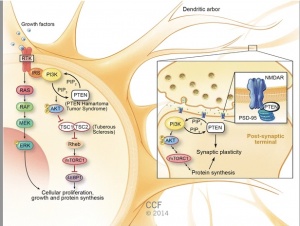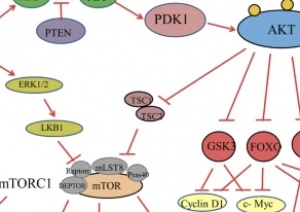Autism symptoms

Autism spectrum disorder is a developmental disability that can cause significant social, communication and behavioral challenges. The learning, thinking, and problem-solving abilities of people with ASD can range from gifted to severely challenged. Some people with ASD need a lot of help in their daily lives while others need less or no help at all. People with ASD might repeat certain behaviors and might not want change in their daily activities. Many people with ASD also have different ways of learning, paying attention, or reacting to things. (CDC et al., 2021). This all comes from the spectrum aspect of ASD; there is such a wide variety of different types of autism. ASD is caused by genetic and environmental influences, but I will be focusing more on the genetic mutations causing ASD, specifically, in the PI3K-AKT/mTOR pathway.
PTEN’s role in the mTOR pathway
PTEN is a lipid and protein phosphatase that regulates cell growth and survival. In PTENS role as a lipid phosphatase, PTEN catalyzes the removal of the 3-phosphate from PIP3, generating PIP2 and directly antagonizing the activity of the class I PI3K. This process leads to multiple cell functions including, growth, survival, gene transcription, protein translation, cytoskeletal organization, and membrane trafficking (Skelton et al., 2019).
PTEN gene mutation

The PTEN protein is part of a signaling network that contains multiple ASD-associated gene products and represents a potentially common etiological mechanism for ASD and related neurodevelopmental disorders. PTEN acts as a lipid phosphatase which inhibits AKT activation by immediately inhibiting PI3K activity (Skelton et al., 2019). Mutation in PTEN causes mTORC1 hyperactivation (Sharma et al., 2021). This upregulation is associated with axonal dysregulation, megalocephaly, alteration of neuron size, protein synthesis, cerebral cell proliferation, and neuronal circuit connectivity between different brain regions.
TSC1/2 gene mutation

TSC is an autosomal dominant hamartomatosis with multisystem involvement in the body. TSC proteins play an important role in transmitting signals from a wide range of cell pathways that inhibit the mTORC1. mTORC1 was identified as long-term neurotransmission that regulates memory and incorporates signals from multiple neural surface receptor sites. This leads to increased mTORC1 activity due to loss of TSC1 and TSC2. This increased activity appears to be what leads to autism (Sharma et al., 2021). TSC is caused by a mutation in the TSC1 or TSC2 gene (Guo et al., 2012). TSC is a high-risk co-morbid disorder of autism spectrum disorder where the mutation of TSC1 or TSC2 dimerizes the signaling of mTOR with a negative effect (Sharma et al., 2021).
Works Cited
Centers for Disease Control and Prevention. (2020, March 25). What is autism spectrum disorder? Centers for Disease Control and Prevention. Retrieved from https://www.cdc.gov/ncbddd/autism/facts.html.
Guo, X., Tu, W.-J., & Shi, X.-D. (2012, September). Tuberous sclerosis complex in autism. Iranian journal of pediatrics. Retrieved from https://www.ncbi.nlm.nih.gov/pmc/articles/PMC3564100/.
Sharma, A., & Mehan, S. (2021). Targeting PI3K-AKT/mtor signaling in the prevention of autism. Neurochemistry International, 147, 105067. https://doi.org/10.1016/j.neuint.2021.105067
Skelton, P. D., Stan, R. V., & Luikart, B. W. (2019). The role of PTEN in Neurodevelopment. Molecular Neuropsychiatry, 5(1), 60–71. https://doi.org/10.1159/000504782